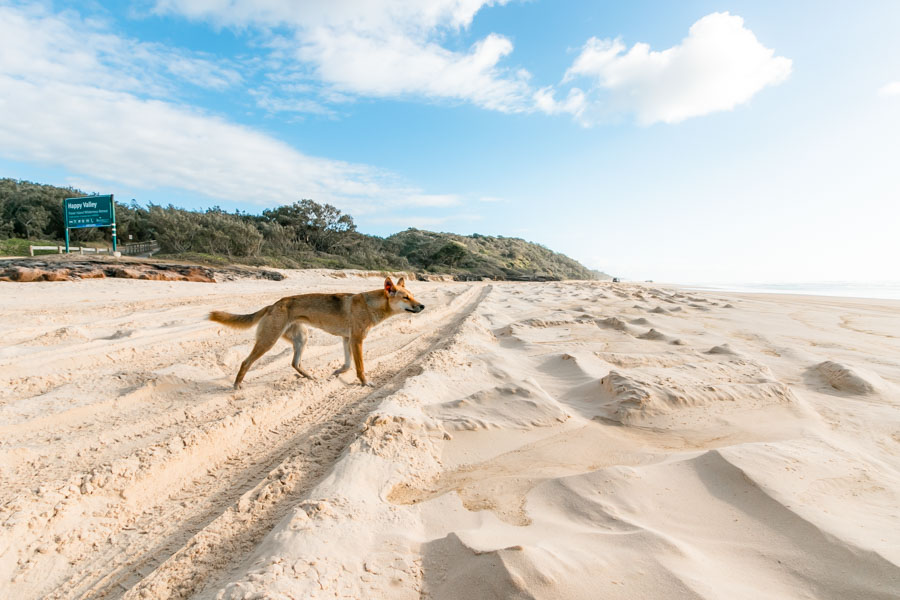Wildlife on Fraser Island
Fraser Island is home to a plethora of wildlife that inhabits a multitude of ecosystems around the island. With different habitats such as lakes, ocean, beach, rainforest and rivers, it is easy to understand why Fraser Island has such a diverse and amazing population of wildlife. Fraser Island is the largest sand island in the world and its plants and wildlife experience isolation from the mainland coast, creating a unique ecosystem for animals to grow and flourish.

Dingoes
Dingoes are probably the most iconic of all the wildlife on Fraser Island. The dingo population on Fraser Island is considered to be one of the purest in Australia due to its isolation and strict park rules. As they are restricted to the island, they do not have the opportunity to cross-breed with other species of wild or domesticated dogs like other dingoes in the rest of Australia. Dingoes are known to be dangerous at times and must be regarded with caution and should never be approached nor fed. Most dingoes on Fraser Island are a sandy colour with black muzzles and white boot markings on their feet. They have bushy tails and pointy ears and weigh around 18kg. While dingoes may look like friendly house dogs, they are in fact very wild animals and can act as such if confronted. Each pack is led by a dominant male and female with a strict social structure within the group. It is said there are up to 19 of these packs on Fraser Island alone!

Whales
While technically not on Fraser Island, humpback whales can easily identify with the Fraser Island landscape. Migrating past the Fraser Coast during their yearly trek up from Antarctica to the north of Australia, they are easily spotted from the shores and lookout points of the island. Since you can see them from both the shoreline and from in the water, these gentle giants can be spotted from both driving tours and boat tours. Humpback whales can grow up to 16m and weigh as much as 30,000kg. During their migration, females often have babies in tow or are looking for a mate among the male humpbacks. Interestingly enough, as they make their way up the coast, they do not eat and instead just focus on rearing their young or mating. They fast until they again reach the cold waters of the Antarctic where they feed on krill for the remainder of the year until migration time comes around again.

Echidnas
The elusive echidna is rarely spotted on Fraser Island due to its shy and sometimes nocturnal nature. It is one of the four species of echidna that live in Australia. They are relatively small in size, reaching only 30 to 45 cm in length and 2 and 7 kgs. Echidnas are monotremes meaning they are egg-laying mammals, like a platypus, which is also found in Australia. Female echidnas only lay one egg per year, which they nurse from milk like other mammals. While generally docile in nature, echidnas are covered in fur and spines that give them a threatening look and have a very distinctive snout which protrudes from their face. Their bodies are designed for digging and foraging and they survive off a diet of insects.
Lace Monitor
Lace monitors, more commonly known as goannas, are found in many places around Australia including Fraser Island. They are part of the monitor lizard family and are often spotted on the ground or in the trees around Fraser Island. They grow up to 2.1 metres in length and live off of a varied diet of pretty much whatever they can find, including other reptiles, small mammals, birds, birds eggs and insects. As opportunistic eaters, they will often forage from humans, attacking chicken coops or ripping open discarded waste. They are also known to eat carrion, feasting on roadkill and other dead animals. They are long and low to the ground with thick limbs and a long tail. They are often dark grey or blueish-black in colour with cream coloured spots and tail bands. They are mostly afraid of people and will run away if encountered.
Turtles
Fraser Island supports both freshwater turtles and sea turtles, which are spotted around the island. Fraser Island's freshwater lakes often consist of clear and extremely clean water, meaning they are often much too pure to support much life within them. However, some of the lakes are home to Krett's River Turtles, short-necked turtles and broad-shelled turtles which manage to have a comfortable life on Fraser Island. Green sea turtles and loggerhead turtles can be spotted in the ocean around the island and come to shore only to lay their eggs.

Along with these animals, there are plenty of other birds, reptiles, mammals, and other sea life you may be able to see while on the island. Fraser Island has a unique habitat that supports an immense diversity of plants and animals, making it the perfect place to enjoy the natural flora and fauna of Australia.












